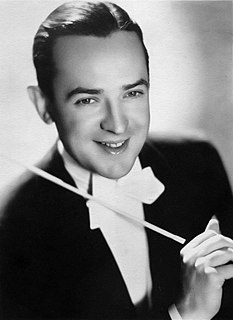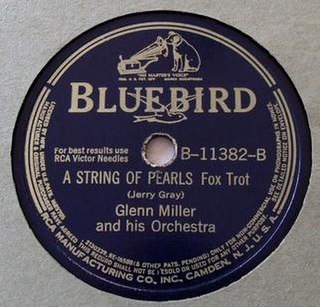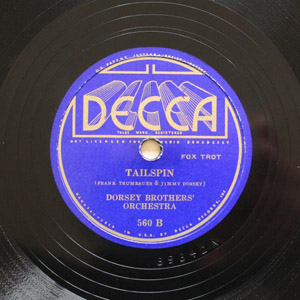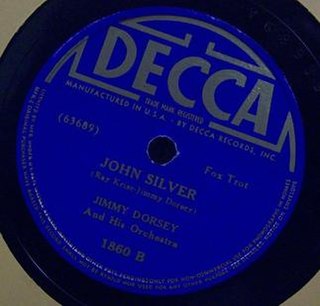

"Harlem Chapel Chimes" is a 1935 jazz instrumental composed by Glenn Miller. The song was released as an A-side 78 single by the Dorsey Brothers Orchestra.


"Harlem Chapel Chimes" is a 1935 jazz instrumental composed by Glenn Miller. The song was released as an A-side 78 single by the Dorsey Brothers Orchestra.
The song was recorded by the Dorsey Brothers Orchestra on February 6, 1935, in New York and released as a 78 single. [1] [2] The song was copyrighted by the music publisher Campbell and Connelly and Company, Ltd., in the UK. Two versions were released: 39337-A was released on British Brunswick Records in the UK as 02149 backed with "Weary Blues", while 39337-C was released on British Decca Records as BM-02149, the American Series. [3] [4] Jimmy Dorsey played clarinet. Tommy Dorsey played trombone on the track. Miller was not on the studio recording session. The arrangement was by Glenn Miller. The instrumental featured a clarinet solo by Jimmy Dorsey with chimes at the beginning and end of the song.
The personnel on the recording: George Thow, Charlie Spivak, trumpet, Tommy Dorsey, Joe Yukl, trombone, Don Mattison, tb, Jimmy Dorsey, clarinet, alto sax, Jack Stacey, alto sax, Skeets Herfurt, tenor sax, Bobby van Eps, piano, Roc Hillman, guitar, Delmar Kaplan, bass, and Ray McKinley, drums.
The Brunswick 78 release was reviewed in the British music magazine, Musical News: Dance Music and Those Who Make It, the May, 1936 issue. Ray McKinley's drumming was highlighted: [5]
I am no particular Dorsey fan, except perhaps for brother Tom's trombone playing, but by hook or by crook you must hear the drumming on both sides of the above. Apart from the actual beats, there is the most seductive, mushy sound, obtained goodness knows how. That is really the only thing I have to say. The band has polish and restraint, but they play the wrong kind of music.
Don't forget them drums.
This instrumental is not to be confused with "Harlem Chapel Bells" which was composed by Glenn Miller orchestra trumpeter Billy May and performed by the band on April 2, 1941, on the Chesterfield radio program.
The instrumental was featured on a Big Band Show program on Glenn Miller which was broadcast on Radio Clyde on 15 December 1981 hosted by Ken Sykora, playing recordings of Glenn Miller as a member of other bands, as a soloist, and rare radio performances.
The recording does not appear on any compilation albums.

Alton Glenn Miller was an American big band trombonist, arranger, composer, and bandleader in the Swing era. He was the best-selling recording artist from 1939 to 1942, leading one of the best-known big bands. Miller's recordings include "In the Mood", "Moonlight Serenade", "Pennsylvania 6-5000", "Chattanooga Choo Choo", "A String of Pearls", "At Last", "(I've Got a Gal In) Kalamazoo", "American Patrol", "Tuxedo Junction", "Elmer's Tune", "Little Brown Jug", and "Anvil Chorus". In just four years, Miller scored 16 number-one records and 69 top-10 hits—more than Elvis Presley and the Beatles did in their careers.

Thomas Francis Dorsey Jr. was an American jazz trombonist, composer, conductor and bandleader of the big band era. He was known as the "Sentimental Gentleman of Swing" because of his smooth-toned trombone playing. His theme song was "I'm Getting Sentimental Over You". His technical skill on the trombone gave him renown among other musicians. He was the younger brother of bandleader Jimmy Dorsey. After Dorsey broke with his brother in the mid-1930s, he led an extremely successful band from the late 1930s into the 1950s. He is best remembered for standards such as "Opus One", "Song of India", "Marie", "On Treasure Island", and his biggest hit single, "I'll Never Smile Again".

James Francis Dorsey was an American jazz clarinetist, saxophonist, composer and big band leader. He recorded and composed the jazz and pop standards "I'm Glad There Is You " and "It's The Dreamer In Me". His other major recordings were "Tailspin", "John Silver", "So Many Times", "Amapola", "Brazil ", "Pennies from Heaven" with Bing Crosby, Louis Armstrong, and Frances Langford, "Grand Central Getaway", and "So Rare". He played clarinet on the seminal jazz standards "Singin' the Blues" in 1927 and the original 1930 recording of "Georgia on My Mind", which were inducted into the Grammy Hall of Fame.

The Dorsey Brothers were an American studio dance band, led by Tommy and Jimmy Dorsey. They started recording in 1928 for OKeh Records.

Michael Andrew "Peanuts" Hucko was an American big band musician. His primary instrument was the clarinet, but he sometimes played saxophone.

Jerry Gray was an American violinist, arranger, composer, and leader of swing dance orchestras bearing his name. He is widely known for his work with popular music during the Swing era. His name is inextricably linked to two of the most famous bandleaders of the time, Artie Shaw and Glenn Miller. Gray, along with Bill Finegan, wrote many of Miller's arrangements during the late 1930s and early 1940s. In the latter part of Gray's career, his orchestra served as the house band at the Venetian Room of the Fairmont Hotel, Dallas.

Leonard William Hambro, known as Lenny Hambro, was a journeyman jazz musician who played woodwinds, primarily alto saxophone, with a host of bands, orchestras, and jazz notables from the early 1940s through the mid-1960s, and continued as a session musician, music producer, booking agent, and entertainment coordinator through the mid-1990s. Early in his professional career, Hambro spelled his name "Lennie" but changed it to the former spelling in 1954, although he was occasionally referred to as "Lennie" in the press as late as 1957. Hambro broke into the profession with Gene Krupa in 1942. However, he is best known for his time as manager and assistant band leader with the New Glenn Miller Orchestra under the direction of Ray McKinley. He was well known in the Latin Jazz community and was closely associated with Chico O’Farrill.

Ernesto Caceres was an American jazz saxophonist born in Rockport, Texas. He was a member of the Glenn Miller Orchestra from 1940–1942.

"I'm Glad There Is You " is a song written by Jimmy Dorsey and Paul Madeira first published in 1941. It has become a jazz and pop standard.

"Room 1411" is a 1928 instrumental composed by Glenn Miller and Benny Goodman and released as a Brunswick 78 by Benny Goodman's Boys. The song was Glenn Miller's first known composition and was an early collaboration between Glenn Miller and Benny Goodman, who would become the most successful bandleaders of the Big Band Era during the 1930s and 1940s.

Annie's Cousin Fannie, which is sometimes listed as "Annie's Cousin Fanny", is a 1934 song composed by Glenn Miller and recorded by The Dorsey Brothers Orchestra for Brunswick and Decca Records. The Dorsey Brothers released two versions of the song in 1934 and 1935.

"It's the Dreamer in Me" is a 1938 song composed by Jimmy Dorsey and Jimmy Van Heusen, which was first recorded by Jimmy Dorsey and His Orchestra with Bob Eberly on vocals. Jimmy Dorsey composed the music. The lyrics were written by Jimmy Van Heusen. The song is a jazz and pop standard.

"A String of Pearls" is a 1941 song composed by Jerry Gray with lyrics by Eddie DeLange. It was notably recorded by Glenn Miller and His Orchestra on RCA Bluebird that November, becoming a #1 hit. The song is a big band and jazz standard.

Dese Dem Dose is a 1935 instrumental composed by Glenn Miller and recorded by The Dorsey Brothers orchestra.

Tailspin is a 1934 song written by Jimmy Dorsey and Frankie Trumbauer. The song was released by Paul Whiteman and His Orchestra featuring Frankie Trumbauer in 1934 on Victor and by The Dorsey Brothers Orchestra in 1935 as a Decca single.

John Silver is a 1938 song written by Jimmy Dorsey with Ray Krise. Jimmy Dorsey and His Orchestra released the song as a 78 single on Decca in 1938.

Community Swing is a swing jazz instrumental composed and recorded by Glenn Miller and released as a Brunswick 78 single in 1937 by Glenn Miller and His Orchestra.

"Tomorrow's Another Day" is a 1935 song composed by Glenn Miller for the Dorsey Brothers Orchestra. The song was released as a 78 single by the Dorsey Brothers Orchestra on Decca Records.

"Singin' the Blues" is a 1920 jazz composition by J. Russel Robinson, Con Conrad, Sam M. Lewis, and Joe Young. It was recorded by the Original Dixieland Jass Band in 1920 as an instrumental and released as a Victor 78 as part of a medley with "Margie". The song was released with lyrics by vocalist Aileen Stanley in 1920 on Victor. In 1927, Frank Trumbauer, Bix Beiderbecke, and Eddie Lang recorded and released the song as an Okeh 78. The Trumbauer recording is considered a jazz and pop standard, greatly contributing to Frank Trumbauer and Bix Beiderbecke's reputation and influence. It is not related to the 1956 pop song "Singing the Blues" first recorded and released by Marty Robbins in 1956.